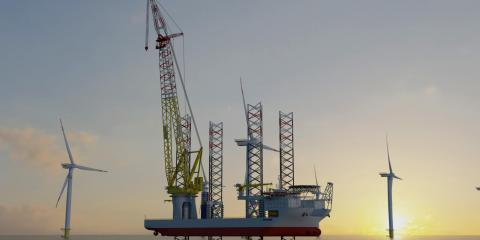Getting ready for the next generation of offshore wind projects

Jan De Nul orders revolutionary Offshore Jack-Up Installation Vessel Voltaire
The global offshore wind industry is developing the next generation of offshore wind turbines. These turbines can be more than 270 metres high and are fitted with blades of 120 metres long. Offshore installation vessels currently available on the market are facing increasing difficulties to install these types of turbines due to the turbines’ sizes and installation heights, as well as the ever-increasing foundation dimensions.
Not only will this vessel be ready for the future of offshore renewables, the Voltaire will also be deployable for the oil and gas industry, and for decommissioning of offshore structures.
The Offshore Jack-Up Installation Vessel is named after the French writer, historian and philosopher François-Marie Arouet, known by his pseudonym Voltaire and as an icon of the European Enlightenment of the 18th Century. Both Voltaire and our Jack-Up Vessel are pioneering within their field of expertise.
Philippe Hutse, Offshore Director at Jan De Nul Group: “Upon her delivery in 2022, we will be capable of efficiently installing the next generation of offshore wind turbine generators and foundations. This investment is a logical step forward in the development of our offshore wind capacities. The third jack-up vessel will enable us to cope with our increased number of offshore wind projects worldwide. In addition, we recognize the global trend towards larger wind turbines for increased green energy demands. The Voltaire will have all the required specifications to meet the upcoming challenges.”
The Voltaire will be environmentally compliant by taking the same highly advanced emission control technology on board as all other Ultra-Low Emission vessels in the Jan De Nul fleet.
Breaking new ground in emission control technology
Jan De Nul Group faces environmental challenges by focusing on minimalizing its footprint of maritime activities on ambient air quality and climate. Air pollution is one of the biggest dangers to public health. Marine construction activities are mostly situated in the vicinity of coastlines, ports and harbours, and densely populated areas.
Being a worldwide leader in marine construction, Jan De Nul Group breaks new ground in emission control technology. The latest generation of Jan De Nul vessels are equipped with a filtering technique for exhaust gases which complies with the stricter European land and inland waterways emission regulations EURO STAGE V.
Whatever fuel or engine technology you use to run your equipment, you always have to filter the exhaust gases. Jan De Nul Group therefore designed the Voltaire running on gasoil but fitted with a highly advanced exhaust gas filtering system by means of a Selective Catalytic Reduction (SCR) system and a Diesel Particulate Filter (DPF).
Jan De Nul already applied this pioneering emission control technology on two trailing suction hopper dredgers and three more, currently under construction. The Voltaire will be the very first seagoing installation vessel of its kind to be such an Ultra-Low Emission vessel (ULEv) and, moreover, EURO STAGE V certified!
Key features of this future-proof Jack-Up Vessel
The Voltaire is specifically designed to transport, lift and install offshore wind turbines, transition pieces and foundations. The vessel will have better operational limits compared to the existing Jack-Up installation vessels.
Key features include a main crane of over 3,000 tonnes, an operating depth of approximately 80 meters, a payload of about 14,000 tonnes and accommodation for 100 persons. The vessel has four legs to lift itself above the sea level for stable working conditions and is equipped with a DP2 system.
Compared to Jan De Nul’s two other jack-up vessels, the Vole au vent and the Taillevent, this new vessel has almost 100 percent more deck space. Not only is this vessel capable of loading the next generation of wind turbines and foundations, the larger deck space will also enable Jan De Nul to optimize installations at sea and to lower the fuel consumption and emissions.
Offshore wind experience worldwide
Jan De Nul Group can rely on its extensive European experience in executing offshore wind farm projects in Belgium, England, Sweden, Denmark, Finland and Germany. This European track record will be further expanded in 2019 with amongst others the construction of the Northwester 2 offshore wind farm in Belgium. This project entails the installation of the world's largest offshore wind turbines currently available on the market: 9.5 MW with a rotor diameter of 164 metres. An important milestone, not only for Jan De Nul and its Clients, but also for the offshore wind industry.
Jan De Nul Group is not only active in Europe but operates worldwide. Mid-2018, Jan De Nul Group entered the Asian offshore wind farm market as the first European contractor, signing contracts for two major offshore wind farm projects in Taiwan: the Formosa 1 Phase 2 OWF project for Formosa Wind Power Co. (construction in 2019) and the Changhua OWF project commissioned by Taiwan Power Company (construction 2020). Both projects are currently under execution.
This investment is a logical step forward in the development of our offshore wind capacities. The third jack-up vessel will enable us to cope with our increased number of offshore wind projects worldwide.
Philippe Hutse
Offshore Director at Jan De Nul Group